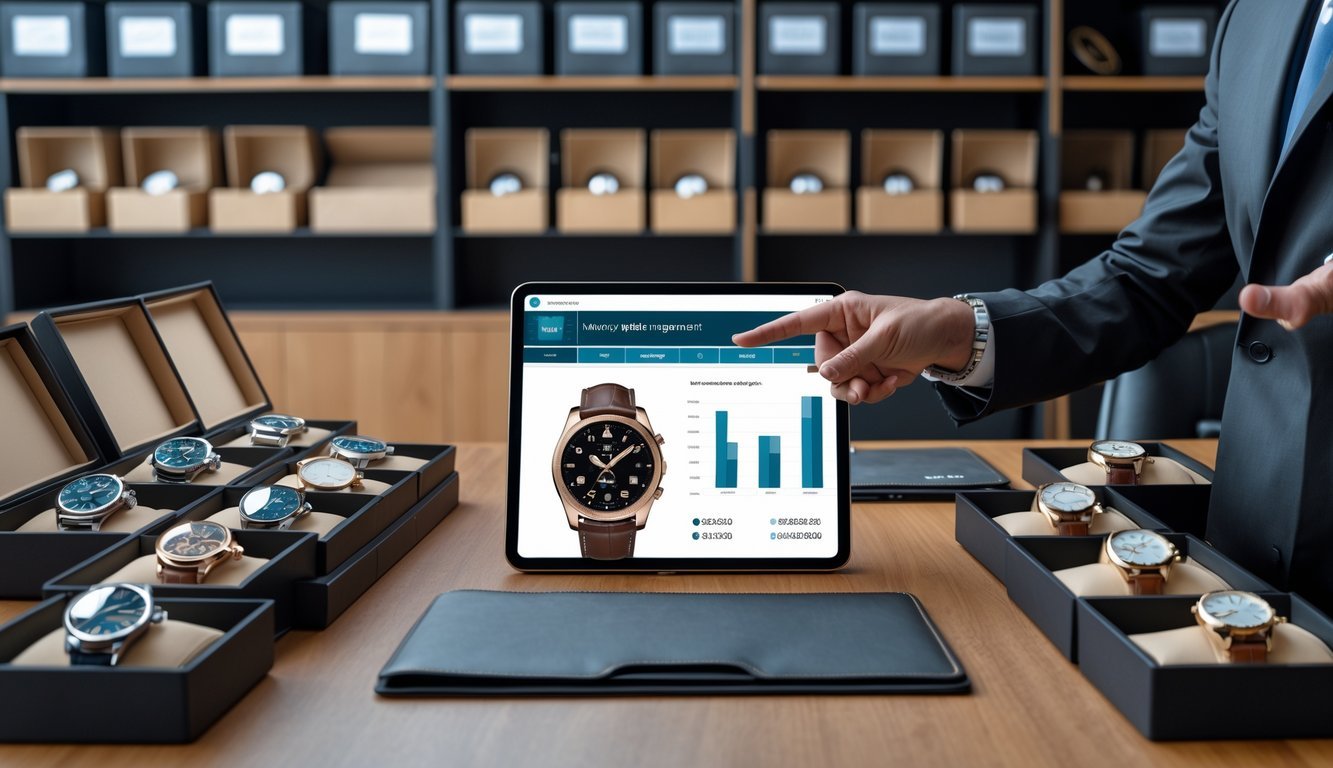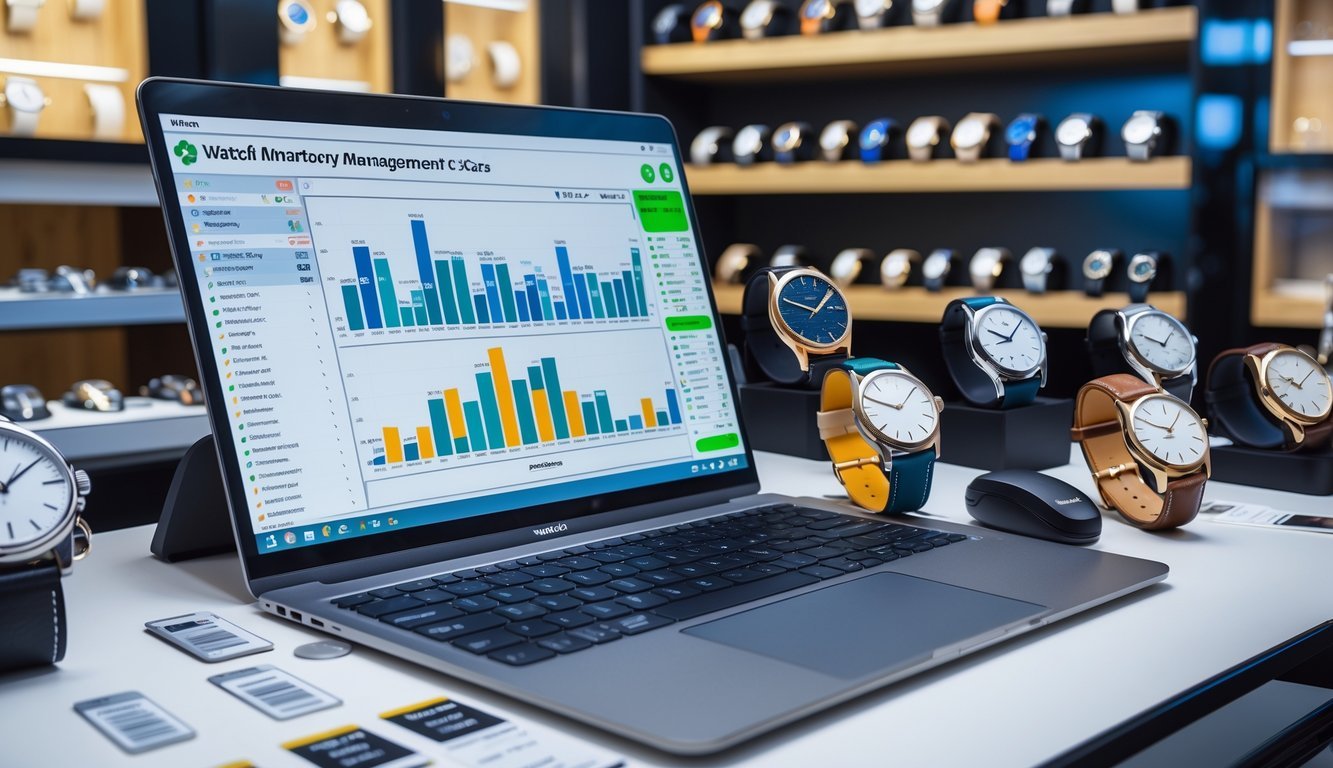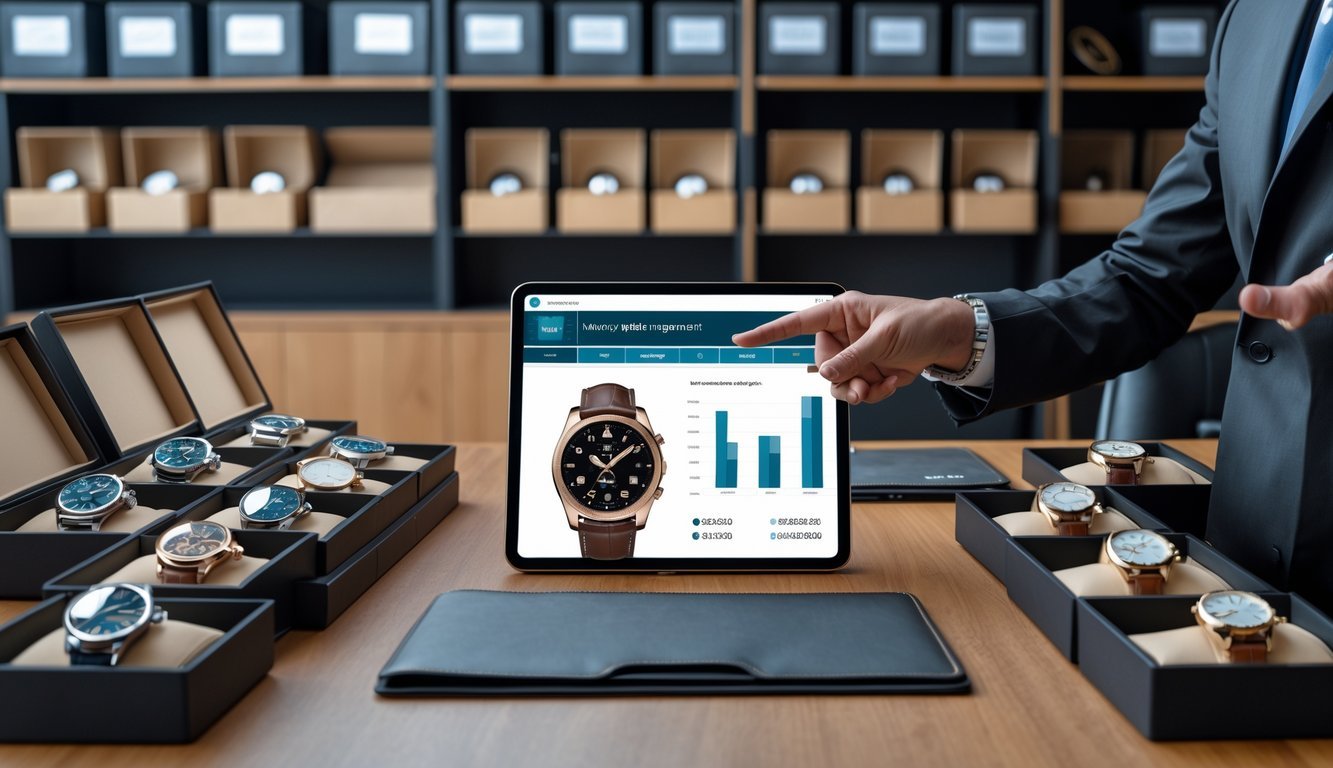Managing watch inventory isn’t just about counting pieces.
It’s a balancing act—making sure you’ve got enough stock to meet demand, without letting extra inventory eat into your profits.
Watch dealers really need clear systems to track inventory, predict what customers want, and keep stock moving.
That’s how you keep profits up and carrying costs low.

Modern watch dealers run into some unique headaches, especially with luxury timepieces that come with high price tags and seasonal swings in demand.
You’ve got to factor in brand popularity, price range, and customer tastes, and those things can shift a lot over time.
These days, technology is stepping up. AI-driven inventory optimization tools now help dealers buy smarter.
They crunch sales data and market trends to suggest the right stock levels for each watch category.
Key Takeaways
- Good inventory management balances customer demand with carrying costs, aiming for solid profits
- Tech and AI tools can predict demand and keep stock levels on target
- Sustainable inventory practices help dealers adjust to changing markets and customer tastes
Core Principles of Watch Inventory Management for Dealers

To manage watch inventory well, you have to track the numbers that matter and keep stock at the right level.
Balance what customers want with what you can actually supply, and keep your product selection focused on what sells.
Critical Inventory Metrics and KPIs
The inventory turnover ratio tells you how many times you sell through your stock each year.
You find this by dividing your cost of goods sold by your average inventory value.
Most watch retailers hit 3-4 turns annually.
High-end watches usually move slower, while fashion watches can sell much faster.
The sell-through rate shows what percent of your inventory you sold in a set period.
It’s smart to track this every month for each brand and price group.
Keep an eye on aging inventory.
If watches sit for over 90 days, it’s time to run a promotion or mark them down.
Gross margin by SKU will show you which items are really making money.
Put your buying power behind high-margin pieces that match customer demand.
Stock-to-sales ratios help you guess what you’ll need next.
Compare current stock with recent sales for each watch category.
Balancing Supply and Demand in the Retail Environment
Look at seasonal trends in your area.
For most retailers, holiday sales can make up 40-50% of the year’s watch revenue.
Pre-order hot models during peak production cycles.
That way, you won’t run out during busy times.
Keep safety stock for supply hiccups.
Swiss suppliers, for example, might take 60-90 days to deliver.
Watch what local customers like and adjust your stock.
In business districts, dress watches sell, but in tourist spots, fashion pieces move quicker.
Use demand forecasting based on your sales history.
Include new releases and discontinued models when planning what to buy.
When there’s a gap between supply and demand, there’s a chance to profit.
Limited editions need careful planning to get the best margins.
SKU Rationalization and Profit Maximization
Cut out slow-moving inventory that ties up your money.
If something sells less than once a year, either discount it heavily or drop it.
Stick to core SKUs that sell regularly.
The 80/20 rule usually applies—20% of your stock brings in about 80% of profits.
Price point optimization is key.
Make sure you cover entry-level, mid-range, and luxury buyers.
Consolidate similar items to keep things simple.
Too many SKUs that do the same thing just complicate your supply chain.
When you consolidate vendors, you get better deals and fewer headaches.
Working with fewer suppliers boosts your buying power and cuts admin time.
Track how much you invest in each category.
Put your money where the profits are, not just where you have a personal favorite or feel vendor pressure.
Advanced Technologies and Sustainable Practices in Watch Inventory

These days, watch dealers are leaning on mobile apps and AI to keep inventory under control.
At the same time, more dealers are trying eco-friendly approaches and making sure they keep customer data safe.
Leveraging Apps for Seamless Inventory Tracking
Mobile inventory apps really change the game.
You can scan barcodes, update stock, and track movement in real time.
Some handy app features:
- Barcode scanning for quick product IDs
- Instant stock updates
- Tracking across multiple locations
- POS system integration
Your phone becomes your inventory sidekick.
You can check availability while talking to a customer or update records right after a shipment comes in.
Cloud apps keep everyone on the same page.
Whether your team uses tablets, phones, or computers, the data stays in sync.
Most top apps work offline too.
You can still track watches without internet, then sync up once you’re back online.
AI-Driven Demand Forecasting and Price Optimization
AI tools can predict which watches will sell and what prices work best.
Dealers using AI see sales jump by 2.3x compared to those who don’t use it.
AI perks for watch dealers:
- Predicting seasonal demand
- Setting prices based on the market
- Suggesting inventory levels
- Analyzing what customers like
Your AI system digs through past sales to guess what’s coming next.
It looks at things like brand trends, seasonality, and local market quirks.
Dynamic pricing algorithms tweak prices based on demand, competition, and how much you’ve got in stock.
That way, you can keep profits up and stay competitive.
Machine learning just keeps getting better.
The more data you feed it, the smarter it gets.
Enhancing Sustainability and Ensuring Privacy Compliance
Going green with your inventory practices cuts waste and attracts eco-conscious buyers.
You can use eco-friendly packaging, plan shipping better, or work with brands that use recycled materials.
Sustainability steps might include:
- Digital receipts and docs
- Smarter packaging
- Grouping shipments
- Battery recycling
Privacy matters too.
You’ve got to protect customer data and follow rules like GDPR and CCPA.
Make sure your inventory system encrypts sensitive info and only lets authorized people see it.
Run security checks regularly to keep data safe from breaches.
Give customers control over their information.
Spell out what data you collect and how you use it in clear privacy policies.
Frequently Asked Questions

Watch dealers run into some tricky problems, from tracking serial numbers to managing consignment pieces.
Knowing best practices and the right software makes things smoother and helps you serve customers better.
What are the best practices for managing inventory in a watch dealership?
Track every watch with a serial number as soon as it arrives.
Each piece should have a unique ID linked to its purchase date, supplier, and warranty info.
Separate your inventory into new, pre-owned, and consignment categories.
That way, you can manage ownership and pricing strategies more easily.
Count your high-value items every month.
For luxury watches, do weekly checks and make sure their condition matches your records.
Set up alerts for watches that stay in inventory more than 90 days.
Slow-moving luxury items tie up cash and might need a price change.
How can a watch dealer effectively track and manage multiple watch brands and models?
Use brand-specific product codes along with your own internal codes.
This combo helps you quickly spot manufacturer details and your own inventory info.
Create separate vendor accounts for each brand.
Track their delivery times, payment terms, and warranty rules.
Set up model templates with standard retail prices, wholesale costs, and key specs.
This saves time when you add similar watches to your system.
Watch brand performance through monthly sales reports.
See which manufacturers give you the best margins and move product fastest.
What are the key features to look for in inventory management software for watch dealers?
Look for software that tracks serial numbers and lets you attach photos.
Each watch entry should include high-res images of the face, case, and movement.
Pick systems that handle consignment tracking automatically.
The software should keep consignment pieces separate and calculate commissions.
Find platforms with built-in repair tracking.
You’ll want to know which watches are out for service and when they’re coming back.
Make sure the system supports different pricing for wholesale, retail, and VIP customers.
Dealers often need separate price levels for different buyers.
How does inventory management affect customer satisfaction in the watch retail sector?
Accurate tracking stops you from promising watches you don’t actually have.
Customers expect quick answers, especially for luxury items.
Real-time stock updates help you suggest alternatives if a specific watch isn’t available.
Offering similar pieces on the spot keeps the conversation going.
Good records help you find watches fast during customer visits.
No one wants to watch you fumble through boxes when they’re spending thousands.
Detailed watch histories let you answer questions about service, previous owners, and authenticity.
Being transparent builds trust with buyers.
Can inventory management systems integrate with other retail systems, like POS and e-commerce platforms, for watch dealers?
Most inventory systems now connect to POS terminals with APIs.
When you make a sale, your stock updates automatically.
E-commerce platforms usually sync up with inventory systems, so your website shows what’s really available.
Sold items come off the site right away, and prices update as needed.
Accounting software integration makes financial reporting easier.
The system can handle cost of goods sold and inventory values automatically.
CRM tools often link to inventory systems too.
This helps you see customer histories and spot likely buyers for certain watches.
What strategies can watch dealers implement to optimize inventory levels and reduce overstock?
Take a close look at your sales data and see if you can spot any seasonal trends in different watch categories.
Maybe sports watches move faster in the summer, while dress watches pick up steam around the holidays.
Try running a consignment program for those high-value pieces that just aren’t selling quickly.
This way, you don’t have to tie up as much cash but can still offer a good selection.
Got watches that just won’t budge? Pair them with popular accessories and sell them as bundles.
Sometimes a package deal makes that slow-seller more appealing and bumps up your average sale.
Set up automatic reorder points using your past sales numbers.
When you’re running low on a hot model, let your system trigger the next purchase order before you run out.
Keep an eye on your competitors’ prices every week and adjust yours when you need to.
If you’re charging too much, those watches will just sit there, eating up your working capital.


